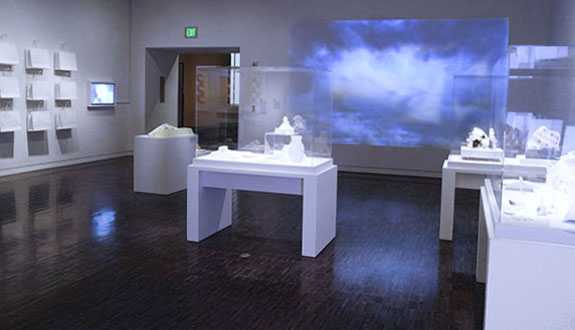 |
_ Handmade paper bag_ Courtesy of the artist(1).jpg) |
Calling to mind John Cusack’s memorable manifesto in Say Anything, the exhibition statement reads, “The concept that almost everyone on the planet touches something that is conceived, mined, manufactured, routed or outsourced in Asia informs this third and final show.”
Amanda Curreri presents the most colorful work in an otherwise muted exhibition. A corner of framed screenprints, two video pieces resting on kimchi pots, a dangling jump rope and an enlarged “Identity and Privilege Card” resting on a mirror shelf tell the story of Curreri’s time spent on the Yongsan Military Base in South Korea. Outside the base, a business with not one but two red, white and blue barbershop poles advertises sexual services available within. This motif recurs in prints, video and a jump rope with the same pattern of red, white and blue plastic beads. A soundtrack of ominous droning and the rhythmic slap of Curreri jumping rope are relentless — referencing a cycle of power Curreri’s work identifies and simultaneously disrupts.
Aesthetically, Cantra is closely mirrored by Unknown, an item in one of Rebeca Bollinger’s three museum vitrines, a piece of ceramic drizzled with silver flashe, a vinyl-based paint with an opaque finish. Her installation, Land, Sea, Air, contains a scattering of porcelain and ceramic shapes (some representational,
, 2011, Amanda Curreri Screenprinted tryptich on paper.jpg) |
some abstract) placed alongside found items. Though she has never been to Japan, objects brought from Tokyo to Los Angeles by her father inform Bollinger’s associations with the country. The arrangements are elegant and evocative, but ultimately incredibly private — a sensation heightened by two plexi cases — one enclosing the other — furthering the remove between viewer and object, maker and consumer.
Byron Peters’ large-scale projection complements Yeh’s investigation into the labor behind objects designed for privileged lives. For Untitled, Peters hired an architectural firm in Shenzhen, China to “produce a rendering of the sky above their workplace.” (Peters succeeded where writer and art historian William Smith failed in 2008 while researching art factories in the same city.) The payment for this dramatic but nondescript image was 50
.jpg) |
Facebook likes, highlighting the intangible nature of labor, product and compensation in a digital, globalized age.
Unlike the previous Proximities exhibits, which clustered around a central sculptural piece, Import/Export is spread out along the edges of the gallery. Tucked into a corner is Jeffrey Augustine Songo’s Blissed Out, a looped video of a robust young Caucasian male clad in brightly colored t-shirt and shorts. He sits cross-legged, his hands on his thighs. The goods here are name-brand athletic gear (probably manufactured in Asia), and the commodification of Eastern practices like yoga and meditation. It’s the least affecting of the bunch, but it’s nice to see another human face (alongside Curreri’s) in midst of all these big ideas.
Though Proximities ends on February 23, there is no reason why there couldn’t be further installments. What about Asia seen through the lens of language, traditional craft, popular culture, appropriation, politics, sports, immigration, labor, ideology, religion, literature and film? The list could go on. Helfand obviously needed to limit himself in the process of curating of these three shows, but Proximities’ engaging premise and thought-provoking results demonstrate that the Asian Museum could benefit by keeping it alive. Injecting new life and relevancy into the museum, both in terms of what it contains and how it reflects contemporary notions of Asia, benefits everyone.
–SARAH HOTCHKISS
Proximities 3: Import/Export @ the Asian Art Museum through February 23, 2014.